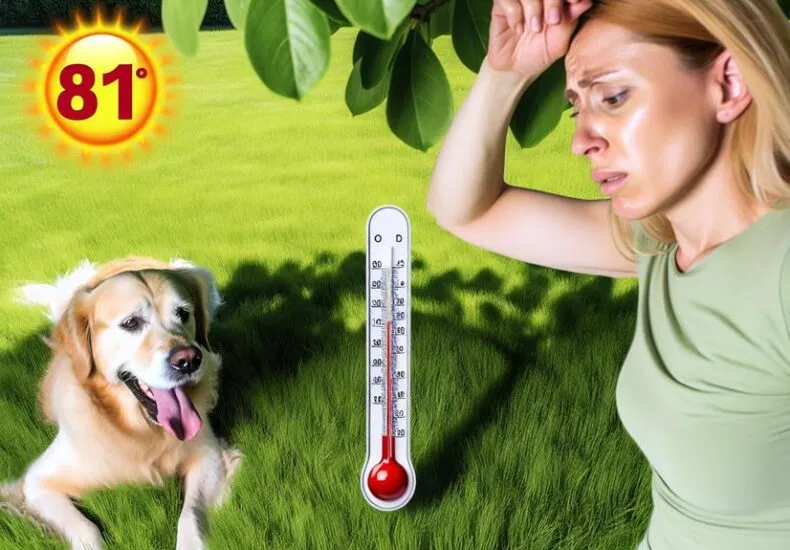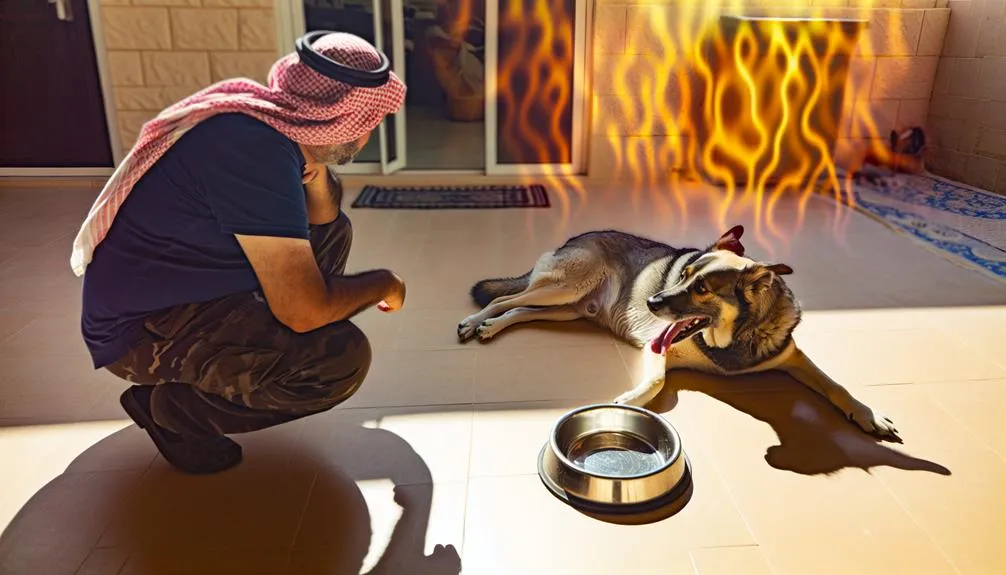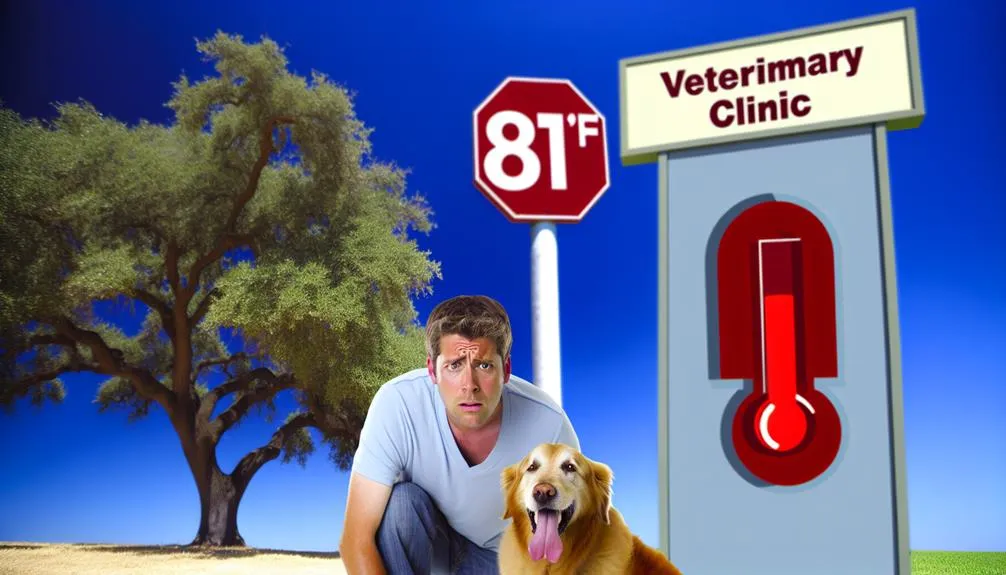
Is 81 Degrees Fahrenheit Too Hot for a Dog
You might think that 81 degrees Fahrenheit is a comfortable temperature for a dog, but the reality is a bit more complex. Certain breeds, especially those with short snouts, can struggle in this heat, putting them at risk for overheating. Even if your dog seems fine, you should be aware of subtle signs that could indicate distress. So, how do you know when it's too hot for your furry friend? Understanding the factors at play can help you make informed decisions about their well-being.
Understanding Canine Temperature Regulation
Dogs have a unique way of regulating their body temperature that differs markedly from humans. Unlike you, dogs don't sweat through their skin to cool down. Instead, they rely on a process known as canine thermoregulation, which primarily involves panting. When your dog pants, moisture evaporates from their tongue, mouth, and respiratory tract, effectively helping to lower their body temperature. This method of cooling is efficient, but it also means that dogs can be more vulnerable to overheating, especially in warmer weather.
Dogs' heat tolerance varies widely among breeds. Breeds with short muzzles, like bulldogs or pugs, often struggle with heat regulation due to their anatomical structure, making them more susceptible to overheating. On the other hand, working breeds, such as Siberian Huskies, might have a greater capacity to handle heat due to their evolutionary background.
Additionally, dogs have a normal body temperature range of about 101 to 102.5 degrees Fahrenheit. If the ambient temperature rises to 81 degrees Fahrenheit, it can become a concern, particularly for those with limited heat tolerance. You should monitor your dog for signs of distress, such as excessive panting, drooling, or lethargy, as these can indicate overheating.
Understanding your dog's unique thermoregulation mechanisms and their individual heat tolerance can help you make informed decisions about their safety in warmer conditions. Always guarantee they have access to fresh water and shade, especially during hot days. Your vigilance plays an essential role in keeping them comfortable and safe.
Factors Influencing Heat Sensitivity
Several factors can influence how sensitive a dog is to heat, extending beyond just breed or size. One of the most significant factors is breed sensitivity. Certain breeds, particularly brachycephalic dogs like Bulldogs and Pugs, have a higher risk of overheating due to their shorter snouts, which can impede effective panting. Additionally, working or sporting breeds with thick coats, like Huskies, may also struggle in warmer temperatures, especially if they're not acclimated.
Age factors play an important role as well. Puppies and senior dogs often have less efficient thermoregulation. Young pups may not have fully developed their ability to cope with heat, while older dogs might suffer from decreased mobility or underlying health issues, making them more susceptible to heat stress. A dog's overall health status, including conditions like obesity or heart disease, can further exacerbate heat sensitivity.
It's vital to take individual variations into account, too. Some dogs may be more resilient to heat based on their previous exposure to warm environments, while others may show signs of distress more readily. Environmental factors like humidity and direct sunlight can also increase heat stress.
Signs of Overheating in Dogs

When the temperature rises, it's vital to recognize the signs of overheating in dogs, as timely intervention can prevent serious health risks. Dogs rely heavily on panting to cool themselves, but when temperatures soar, this method may become ineffective. You should monitor your dog's behavior closely, especially during warm days, to guarantee they're not suffering from heat stress.
Here are some common signs of overheating:
| Behavioral Signs | Physical Signs |
|---|---|
| Excessive panting | Elevated heart rate |
| Restlessness | Lethargy |
| Seeking shade | Drooling |
| Loss of coordination | Vomiting |
| Whining or barking | Bright red gums |
If you notice any of these symptoms, it's imperative to act quickly. Dogs may have different hydration needs based on their activity levels and environmental conditions. Dehydration can exacerbate overheating, so make certain your dog has access to fresh water at all times.
Ignoring these signs can lead to heat exhaustion or heat stroke, both of which can be life-threatening. Understanding your dog's behavior can help you identify when they're struggling. Always keep an eye on your pet, especially during prolonged outdoor activities in the heat. Your vigilance can make a difference in keeping your furry friend safe and comfortable.
Tips for Keeping Dogs Cool
As temperatures climb, keeping your dog cool becomes essential for their health and comfort. Dogs don't sweat like humans do; instead, they rely on panting and other behaviors to regulate their body temperature. To help your furry friend beat the heat, start by ensuring they have constant water availability. Fresh, cool water should always be accessible, especially during warmer months. Hydration plays a vital role in preventing overheating and maintaining their overall well-being.
Next, consider your dog's environment. Providing ample shade options can greatly reduce the risk of heat-related issues. Whether you're outside or at home, set up a shaded area where your dog can retreat when the sun is at its peak. This could be under a tree, an umbrella, or even a doggy tent. If your dog spends time indoors, make sure they have a cool, airy space away from direct sunlight.
You can also use cooling mats or vests designed specifically for dogs. These products can help regulate their body temperature and provide an additional layer of comfort. During hot days, limit outdoor activities to early mornings or late evenings when the temperatures are lower, and always keep an eye on your dog for signs of overheating.
When to Seek Veterinary Help

Recognizing the signs of overheating in your dog is essential, especially after exposure to high temperatures like 81 degrees Fahrenheit. Dogs can't regulate their body temperature as effectively as humans, making them susceptible to heat-related illnesses, including heat stroke. If you notice your dog is excessively panting, drooling, or showing signs of distress, it's imperative to act quickly.
Look for additional symptoms such as lethargy, weakness, or vomiting. These can indicate that your dog is in danger. If their gums appear bright red or pale, it's a sign of serious dehydration or heat stress. When you observe these signs, don't hesitate to seek veterinary help. Early intervention can save your dog's life.
Hydration is essential in preventing heat stroke, but if your dog is already showing symptoms, they may need intravenous fluids for proper rehydration. A veterinarian can assess your dog's condition and provide the necessary treatments, including cooling techniques and medications to stabilize their temperature.
It's important to remember that even if your dog seems to recover after cooling them down at home, a veterinary check-up is still advisable. Some effects of heat stroke can be delayed and may not be immediately apparent. Always err on the side of caution. Keeping a close eye on your dog during hot days and knowing when to seek professional help can make all the difference in ensuring their safety and well-being.
Frequently Asked Questions
Can All Dog Breeds Tolerate 81 Degrees Fahrenheit?
Not all dog breeds have the same temperature tolerance. While some adapt well to warmer temperatures, others may struggle. Always consider your dog's breed and individual acclimation when evaluating their comfort in heat.
What Activities Are Safe for Dogs in Warm Weather?
When summer's blazing, your dog's safety matters. Engage in water activities like swimming, and guarantee plenty of shade options. Always monitor their energy levels; hydration's key to keeping your furry friend cool and happy.
How Long Can Dogs Stay Outside in 81 Degrees?
In 81 degrees, dogs can typically stay outside for about 30 minutes to an hour. Always monitor for signs of heat exhaustion and guarantee they have access to fresh water to meet their hydration needs.
Are Puppies More Sensitive to Heat Than Adult Dogs?
Yes, puppies are generally more sensitive to heat than adult dogs due to their developing bodies. When practicing puppy care, always monitor their behavior in warm conditions to prevent overheating and guarantee their safety.
Can Indoor Dogs Be Affected by Outdoor Temperatures?
Yes, indoor dogs can definitely be affected by outdoor temperatures. They're sensitive to temperature changes, and maintaining indoor comfort is essential. If it's hot outside, make certain they have a cool, shaded environment inside.
Conclusion
To sum up, while 81 degrees Fahrenheit may not seem scorching to you, it can feel like a furnace to your furry friend, especially for those sensitive breeds. Always keep an eye on your dog's behavior and provide plenty of water and shade. Remember, preventing overheating is crucial for their health and happiness. If you notice signs of distress, don't hesitate to seek veterinary help—your dog's well-being is worth its weight in gold.
You may also like
Archives
Calendar
| M | T | W | T | F | S | S |
|---|---|---|---|---|---|---|
| 1 | 2 | 3 | 4 | 5 | 6 | |
| 7 | 8 | 9 | 10 | 11 | 12 | 13 |
| 14 | 15 | 16 | 17 | 18 | 19 | 20 |
| 21 | 22 | 23 | 24 | 25 | 26 | 27 |
| 28 | 29 | 30 | ||||
Leave a Reply